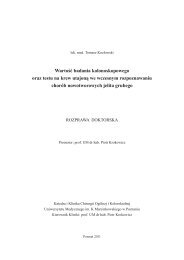MILITARY PHARMACY AND MEDICINE
MILITARY PHARMACY AND MEDICINE
MILITARY PHARMACY AND MEDICINE
Create successful ePaper yourself
Turn your PDF publications into a flip-book with our unique Google optimized e-Paper software.
© Military Pharmacy and Medicine • 2012 • 4 • 43 – 50Jerzy Z. Nowak: Non-steroidal anti-inflammatory drugs (NSAIDs) in …Compared to the cornea, higher concentrationsof the drug are reached in the ciliary body andthe retina (the rate of conversion of nepafenac toamfenac expressed in pM/min/mg of human tissuewas 0.26 for cornea and 0.39 for the iris/ciliarybody complex; at higher concentrations of the substrate(nepafenac), the respective values were 107and 454, while the value for the retina/uvea complexwas 135 [21]. Applying the drug three times aday guarantees the achievement and maintenanceof amfenac levels that effectively inhibit the COXactivity and prostaglandin production within theocular structures.Many years before ophthalmic nepafenac (Nevanac),amfenac sodium (AHR-5850) was registeredunder the trade name Fenazox in Japan(1986) for systemic use in patients with rheumaticdiseases. Several analogs of amfenac (or2-amino-3-benzoylbenzeneacetic acid) were synthesizedto improve its biological activity profile,i.e. increase the therapeutic index and reduce theadverse effects; these analogs included the amidederivative — 2-amino-3-benzoylbenzeneacetamide(or nepafenac). However, it turned outthat nepafenac’s effect on COX was very weak,but its metabolite formed in the body, amfenac,had a stronger in vivo inhibitory activity againstPGHS, with IC50 values (in µM) against COX-1being 0.25 for amfenac and 64.3 for nepafenac(in parallel studies, the IC50 for diclofenac was0.12 µM); amfenac’s IC50 against COX-2 was 0.15[22]. It should be mentioned that amfenac, withits analgesic effect stronger that that of phenylbutazoneand aspirin in animals, was consideredas a potential oral analgesic at the dose of 100 mgin humans, with rapid onset and many hours’duration of therapeutic action [23].Thus, amfenac (sodium) was the original drug,while nepafenac was developed as an improvedversion — a precursor of amfenac sodium (AHR-5850). In early 1980s, amfenac was tested in detailedtoxicological and comparative studies (withindomethacin, acemethacin, diclofenac and ketoprofen)in rodents, which served as the basis forthe assessment of safety and dosage in humans.Bromfenac2-[2-amino-3-(4-bromobenzoyl)phenyl]acetic acid[C 15H 12BrNO 3; MW 334.16 g/mol] — a derivativeof phenylacetic (arylacetic) acid (Fig. 4).http://military.isl-journals.comFigure 4: Chemical structure of nepafenac, amfenac andbromfenac.As a result of action of tissue hydrolases, nepafenac (with minor effect on cyclooxygenase– COX) is converted to the biologically active amfenac, a strong inhibitor ofCOX-1 and COX-2 activity. It is interesting to note that bromfenac differs from amfenacstructure with the presence of a bromine atom at the 4th position in benzene ring. Likeamfenac, bromfenac is a strong inhibitor of COX activity.The history of bromfenac is short but interesting anddidactic, and therefore deserves being mentioned. Beforethe compound became an active substance in ophthalmicproducts, it was originally an ingredient of oraldrugs. It was available in oral drugs for a short but dramaticperiod. In July 1997, US FDA registered a drugnamed Duract by Wyeth-Ayerst (capsules containing 25mg of bromfenac) for short-term (lasting up to 10 days)treatment of various pain conditions (headaches, muscles,teeth, menstrual pains, post-traumatic pains) andreduction of inflammation symptoms. Due to its stronganalgesic effect, Duract (Bromfenac-Oral), used in theregimen of 1 capsule or 2 capsules taken with mealsevery 6-8 h, with total daily dose not exceeding 150mg — was to offer an alternative to the abused opiate analgesicsin cases of severe pains. Duract grew on popularityand quickly made it to the top of the list of the newpainkillers; according to IMS America, nearly 1.3 millionprescriptions were issued in the US within less thanone year [The Associated Press, Washington, February11, 1998]. Contrary to numerous well-known adverseeffects of opiate treatments, short-term use of Duractwas expected to be safe, and the side effects stated by themanufacturer included only less important symptomssuch as stomach upset as the most common ailment,possible abdominal pains and headaches, nausea andvomiting; less common effects dizziness, somnolenceand blurred vision. In the meantime, US FDA pointedout that jaundice, hepatitis, and even severe hepatic insufficiencyrequiring liver transplant were observed insome Duract (Bromfenac-Oral) recipients, particularlyin patients taking the drug form more than 10 days. Inconsequence, Duract (Bromfenac-Oral) was withdrawnfrom the pharmaceutical market by FDA’s decisiondated 22 June, 1998, due to the risk of severe hepaticcomplications, after only 11 months on the market.43
















